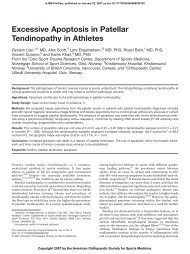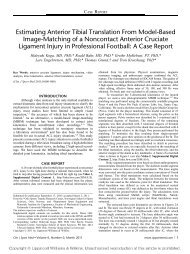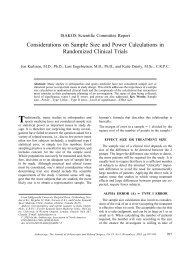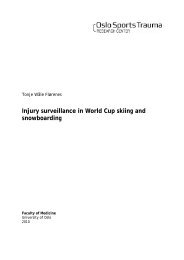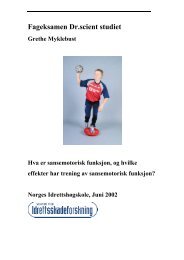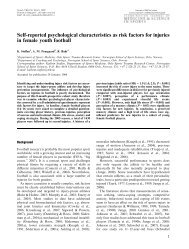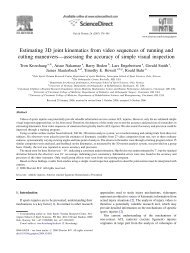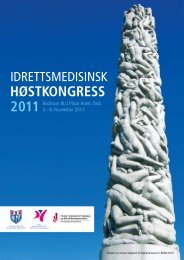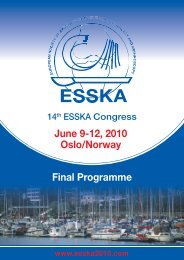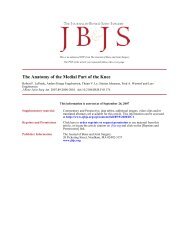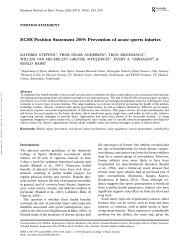Use of bisphosphonates for the treatment of stress fractures in athletes
Use of bisphosphonates for the treatment of stress fractures in athletes
Use of bisphosphonates for the treatment of stress fractures in athletes
Create successful ePaper yourself
Turn your PDF publications into a flip-book with our unique Google optimized e-Paper software.
Knee Surg Sports Traumatol Arthroscstreng<strong>the</strong>n itself when subjected to high stra<strong>in</strong>s or stra<strong>in</strong>rates, or new stra<strong>in</strong> patterns. Milgrom et al. [49] haveshown <strong>in</strong> <strong>the</strong>ir <strong>in</strong> vivo human bone stra<strong>in</strong> gauge study thattibial <strong>stress</strong> <strong>fractures</strong> are likely due to bone remodel<strong>in</strong>g,while metatarsal <strong>stress</strong> <strong>fractures</strong> are caused by cyclicoverload<strong>in</strong>g alone.Over <strong>the</strong> past decade, <strong>bisphosphonates</strong> have been widelyused to treat a variety <strong>of</strong> bone diseases and have beenshown to <strong>in</strong>crease bone mass and decrease fracture risk <strong>in</strong>postmenopausal, osteoporotic women. The marked <strong>in</strong>hibitoryaction <strong>of</strong> <strong>bisphosphonates</strong> on osteoclast-mediated boneresorption has also led to successful <strong>treatment</strong> <strong>of</strong> pathologicprocesses associated with <strong>in</strong>creased bone remodel<strong>in</strong>gsuch as Paget’s disease, bone tumors, and metastases.Given <strong>the</strong>ir <strong>in</strong>hibitory action on osteoclast activity, shorttermsuppression <strong>of</strong> bone remodel<strong>in</strong>g us<strong>in</strong>g <strong>bisphosphonates</strong>could prevent <strong>the</strong> <strong>in</strong>itial bone loss observed dur<strong>in</strong>g<strong>the</strong> remodel<strong>in</strong>g response to high bone stra<strong>in</strong>s and potentiallyprevent <strong>stress</strong> <strong>fractures</strong> [19]. This concept is not new.Physicians have empirically treated <strong>athletes</strong> who sufferfrom <strong>stress</strong> <strong>fractures</strong> with <strong>bisphosphonates</strong>, but this iscontroversial and has not been well <strong>in</strong>vestigated [3, 24].The present review summarizes and discusses <strong>the</strong>current understand<strong>in</strong>g and <strong>the</strong> potential role <strong>of</strong> <strong>bisphosphonates</strong><strong>for</strong> <strong>the</strong> <strong>treatment</strong> and prevention <strong>of</strong> <strong>stress</strong><strong>fractures</strong> <strong>in</strong> <strong>athletes</strong>.remodel<strong>in</strong>g, which prevents <strong>the</strong> <strong>in</strong>creased porosity associatedwith remodel<strong>in</strong>g and ma<strong>in</strong>ta<strong>in</strong>s lower stra<strong>in</strong>s on <strong>the</strong>bone, can prevent <strong>stress</strong> <strong>fractures</strong>.One would expect that an <strong>in</strong>crease <strong>in</strong> bone remodel<strong>in</strong>gwould be accompanied by an elevation <strong>of</strong> serum or ur<strong>in</strong>ebiochemical markers that reflect <strong>the</strong> remodel<strong>in</strong>g process. In<strong>the</strong>ir prospective study, Murguia et al. [53] detected asignificant <strong>in</strong>crease <strong>in</strong> plasma hydroxyprol<strong>in</strong>e dur<strong>in</strong>g <strong>the</strong>first week <strong>of</strong> military tra<strong>in</strong><strong>in</strong>g <strong>in</strong> a group <strong>of</strong> recruits whosubsequently presented with <strong>stress</strong> <strong>fractures</strong>, compared tothose who did not. This showed that an <strong>in</strong>itially higherbone remodel<strong>in</strong>g rate is a risk factor <strong>for</strong> subsequent <strong>stress</strong><strong>fractures</strong>. Accord<strong>in</strong>g to this result, preventive bisphosphonate<strong>treatment</strong> may be feasible <strong>for</strong> those who have<strong>in</strong>creased bone remodel<strong>in</strong>g at basel<strong>in</strong>e. However, Bennellet al. [8] reported that bone remodel<strong>in</strong>g <strong>in</strong> <strong>athletes</strong> whodeveloped <strong>stress</strong> <strong>fractures</strong> was not different from those whodid not develop <strong>stress</strong> <strong>fractures</strong> at basel<strong>in</strong>e, or immediatelyprior or subsequent to <strong>the</strong> start <strong>of</strong> bone pa<strong>in</strong>. The resultsfrom military recruits may not generalize to <strong>athletes</strong> as <strong>the</strong>yrepresent a different population. Failure to detect <strong>in</strong>creasedbone remodel<strong>in</strong>g, ei<strong>the</strong>r prior to or follow<strong>in</strong>g <strong>the</strong> onset <strong>of</strong><strong>stress</strong> <strong>fractures</strong> <strong>in</strong> <strong>athletes</strong>, may reflect overall total bodybone remodel<strong>in</strong>g and <strong>the</strong> tests may not be sufficientlysensitive enough to detect locally accelerated boneremodel<strong>in</strong>g.Pathogenesis <strong>of</strong> <strong>stress</strong> <strong>fractures</strong> and <strong>the</strong> relationshipto <strong>bisphosphonates</strong>As stated above, <strong>stress</strong> <strong>fractures</strong> occur when a bone fails toremodel adequately follow<strong>in</strong>g <strong>the</strong> application <strong>of</strong> repetitivesub-threshold <strong>stress</strong>. The first stage <strong>of</strong> bone remodel<strong>in</strong>g<strong>in</strong>volves bone resorption, which fur<strong>the</strong>r weakens <strong>the</strong>already compromised bone [19]. A ma<strong>the</strong>matical modelproposes that <strong>the</strong> porosity <strong>in</strong>troduced by remodel<strong>in</strong>g contributesto an unstable situation <strong>in</strong> which a <strong>stress</strong> fracturewill occur [44]. Experimental studies with a rabbit impulsiveload<strong>in</strong>g model [17] also suggested that a positivefeedback between load<strong>in</strong>g and remodel<strong>in</strong>g might be afeature <strong>of</strong> <strong>stress</strong> fracture pathogenesis. By 6 weeks <strong>of</strong>load<strong>in</strong>g, activation <strong>of</strong> new bone remodel<strong>in</strong>g had <strong>in</strong>creasedfur<strong>the</strong>r still and <strong>the</strong>re was a tenfold <strong>in</strong>crease <strong>in</strong> bone microdamage.The <strong>in</strong>cidence <strong>of</strong> overt <strong>stress</strong> <strong>fractures</strong> <strong>in</strong> <strong>the</strong>seanimals had <strong>in</strong>creased to 68% after 6 weeks. These datasuggest that overload<strong>in</strong>g first creates a biological remodel<strong>in</strong>gresponse, which is associated with <strong>the</strong> early signs <strong>of</strong> a<strong>stress</strong> fracture. Cont<strong>in</strong>ued load<strong>in</strong>g causes acceleration <strong>of</strong>bone microdamage accumulation, which fur<strong>the</strong>r <strong>in</strong>creases<strong>the</strong> <strong>in</strong>cidence <strong>of</strong> <strong>stress</strong> <strong>fractures</strong>, perhaps through a positivefeedback mechanism [19]. Taken toge<strong>the</strong>r, <strong>the</strong>se experimentshave suggested that <strong>the</strong> suppression <strong>of</strong> boneEffect <strong>of</strong> <strong>bisphosphonates</strong> on fracture heal<strong>in</strong>gOver <strong>the</strong> years, <strong>the</strong>re have been concerns about whe<strong>the</strong>r ornot <strong>bisphosphonates</strong> <strong>in</strong>terfere with <strong>the</strong> fracture heal<strong>in</strong>g.Because <strong>the</strong>y suppress bone remodel<strong>in</strong>g, one might expectthat <strong>bisphosphonates</strong> <strong>in</strong>terfere with fracture repair. Li et al.[37] have reported <strong>in</strong> a grow<strong>in</strong>g rat model us<strong>in</strong>g <strong>in</strong>cadronatethat bisphosphonate <strong>treatment</strong> resulted <strong>in</strong> a largerfracture callus and delayed maturation <strong>of</strong> <strong>the</strong> fracture.Alendronate <strong>treatment</strong> also suppressed remodel<strong>in</strong>g <strong>of</strong> <strong>the</strong>fracture callus <strong>in</strong> ovariectomized rats [20]. These changesmay be secondary to <strong>in</strong>hibition <strong>of</strong> bone resorption becausebone <strong>for</strong>mation and resorption are <strong>in</strong>timately l<strong>in</strong>ked. Conversely,<strong>the</strong>re are reassur<strong>in</strong>g reports on this topic that showfracture callus remodel<strong>in</strong>g is not a problem <strong>in</strong> severalanimal models unless very high doses <strong>of</strong> <strong>bisphosphonates</strong>are used [7, 25].In contrast to <strong>the</strong>se concerns, <strong>the</strong>re are now severalreports suggest<strong>in</strong>g that <strong>bisphosphonates</strong> may actuallyenhance fracture repair, probably by stabiliz<strong>in</strong>g <strong>the</strong> fracturecallus [42]. O<strong>the</strong>r studies relevant to this problem <strong>in</strong>clude<strong>the</strong> improved osseo<strong>in</strong>tegration <strong>of</strong> metal implants <strong>in</strong> ovariectomizedrats treated with ibandronate [34]. There are alsopotential applications <strong>of</strong> <strong>bisphosphonates</strong> <strong>in</strong> orthopedics,<strong>in</strong>clud<strong>in</strong>g improved heal<strong>in</strong>g <strong>in</strong> distraction osteogenesis [39,123




